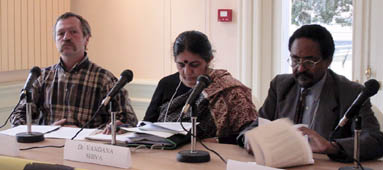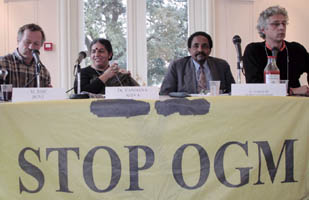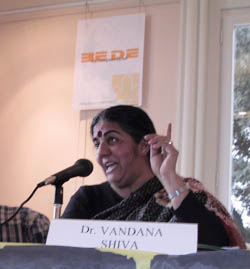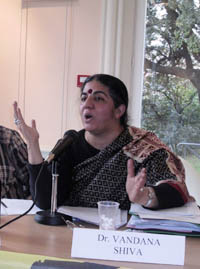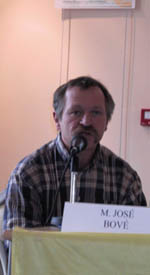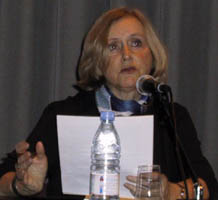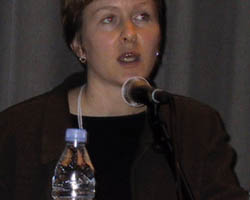 
|
|
|
First Meeting of the Intergovernmental Committee for the Cartegena Protocol (ICCP1) Montpellier,
FRANCE Première Réunion du Comité Intergouvernemental pour le Protocole de Cartegena |
|
|
| Monday
11 | Tuesday 12 | Wednesday
13 | Thursday
14 | Friday 15 | Summary | |
|
Transgenic Golden Rice : a GMO against malnutrition? The Response from the South A3D (Association des Acteurs Africains du développement) and BEDE
(Bibliotheue d'échange de documentation e
d'expériences) organized this side event addressing genetically-modified
rice and the industry illusion of correcting malnutrition with
biotechnologies. See http://www.globenet.org/bede/
Tewoldi Gebre Egziabher focused his presentation on the genetic engineering aspect of biotechnology, whereby genes are loaded onto a parasitic vector in order to penetrate a target genome. Because the net results of such engineering are not fully understood and may only be recognized far into the future, Tewoldi stated that current commercial field trials and risk assessments were not sufficient. The introduction of new species, new enzymes, and new byproducts of the biotechnology industry may have long-term effects requiring increasingly greater reliance on genetic engineering. distrusting biotechnology companies' commercial interests, Tewoldi warned against a possible future whereby the need for genetically engineered food shifts production away from farmers and their national governments, and introduces technological reliance on a few profit-motivated corporations.
Vandana Shiva opened her presentation by clearly stating that there are several reasons why Golden Rice and other genetically engineered food projects should be shelved. Shiva described human Vitamin A deficiencies as one result of the Green Revolution of agricultural industrialization, which established monoculture practices, agricultural intensification, massive pesticide/herbicide use to eliminate competitive species; developments that have left agricultural products weakened and created structural imbalances in the industry. Taking into account this history of industrialization, current developments in biotechnology to fortify food to treat the malnourished is thus said to be "incestuous propaganda" to make a past technological failure look like a technological miracle. Shiva also warned against the potential for the development of dependency, replacing indigenous production, erasing local or traditional knowledge and practices, and restructuring the food system into a corporate one. José Bové speaking as a farmer and representing the Confédération Paysanne, stated that genetically modified organisms were not the answer to malnourishment in the world. Bové encouraged more public research, sovereignty in food safety, and respect for biodiversity. |
|||||||||
|
The U.S. and the Precautionary Principle:
Nancy Meyers presented responses to internal US State Department discussions on the precautionary principle in the interests of elucidating such arguments which have been raised in negotiations on the Protocol, international trade, environment and food safety discussions. Meyers' microscopic examination of the precautionary principle was an instructive presentation on how the principle could be invoked, with a view to present issues of uncertainty within risk assessments associated with biosafety and genetically modified organisms. While confirming that the principle is indeed about precaution, Meyers made the point that it is a process of acknowledging our values (ethics), examining what we do and do not know (science), and acting accordingly. Discussions centered upon the contestable concepts of whose values, whose knowledge and whose actions were actually being questioned and, in light of this relative positioning, whether existing applications of the principle were indeed questionable. Katherine Barrett presented her paper "Applying the precautionary principle to agricultural biotechnology"; a framework for applying the principle to the release of genetically engineered crops. Barrett reports that clearer definitions of harm should be acknowledged, and that there exists a scientific error bias toward safety where there should be an error bias of caution, hence, cross-disciplinary research and the incorporation of traditional knowledge should be encouraged; and inter alia, that the burden of proof should be shifted to the developers of potentially hazardous technologies, and require them to operate in open, transparent processes subject to review by independent third parties. More information can be found at http://www.sehn.org/precaution.html |
|||||||||
|
Relevant Information:
Past IISD Coverage:
| |||||||||
